The Persian al-Biruni (c. 1000)
Αl-Biruni (973–1048), even though little known in the Western world, was one of the greatest master scientists of all time. He was an astronomer, philosopher, mathematician, physicist, historian, geographer, pharmacist, geodesist, traveler, geologist, cartographer and anthropologist, and his scientific body of work is estimated as exceeding 150 books, in which he addresses almost all the sciences.1 He had excellent knowledge of ancient Greek and, as noted by D. Tsibukidis, had studied dozens of works by ancient Greek scientists in their original forms.2
George Sarton, the so-called father of the History of Science and professor at the University of Harvard, stated that al-Biruni was “one of the very greatest scientists of Islam, and, all considered, one of the greatest of all times.”3 Another professor of the History of Science at the Universities of Harvard and Alexandria, Abdelhamid I. Sabra, has called al-Biruni “one of the great scientific minds in all history.”4
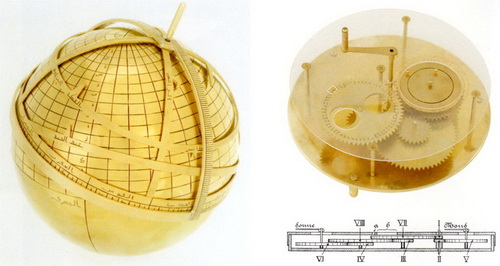
Left, a model of a round astrolabe and to the right a model of a mechanical sun and moon calendar. Both models were constructed based on the designs and descriptions of al-Biruni and are found at the Institute for the History of Arabic-Islamic Science at the University of Frankfurt. The images come from the work of the director of the Institute, Prof. Dr. Fuat Sezgin, entitled Science and Technology in Islam.
In order to comment on his varied body of work and his scientific contribution a large volume would be required. As an example, we may mention one of his scientific triumphs: he calculated the earth’s radius as 6339.9 km, which deviates from the true value by just 16.8 km. As underlined by mathematicians John J. O’Connor and Edmund F. Robertson, this value was calculated in the West only in the sixteenth century, half a millennium later.5
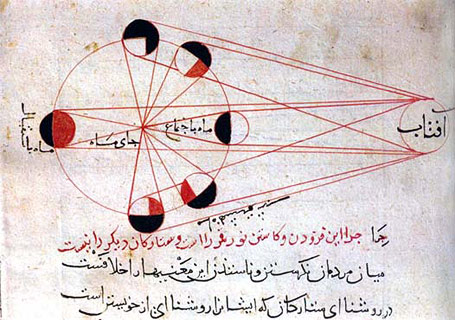
A Persian manuscript with a design by al-Biruni that explains the moon’s eclipses. He had observed the lunar eclipse of 17 September 1019 and had recorded the exact latitudes of the stars.
Of the 150 works by al-Biruni, only 22 have been preserved, among which is Αl-Athar al-baqiyah (The Chronology of Ancient Nations), which according to the German scholar Eduard C. Sachau, was written around the year 1000.6 In this work the Persian polymath, in a chapter that makes reference to the Christian celebration of Easter, records all he knew about the rite of the Holy Fire.
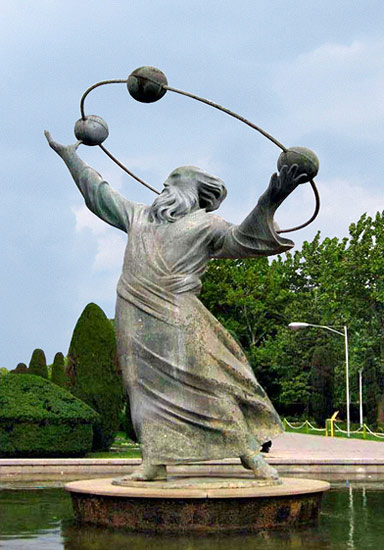
Statue of al-Biruni in the Laleh park in Teheran.
The work is preserved in five manuscripts7 and was first published in 1878 by E.C. Sachau.8 However, as was discovered later, the edition was incomplete because the manuscript that was used did not contain the chapter on the Holy Fire ceremony as well as other parts of al-Biruni’s original work.
In 1912, the AsiaticMuseum in St Petersburg acquired a manuscript of the same work that was older than that used by E.C. Sachau. This manuscript, which was complete and contained the chapter on the Holy Fire, became known for the first time by the head of the Asiatic Museum, Carl H. Salemann.9
The excerpt of the manuscript that makes reference to the Holy Fire ceremony was published in 1915 by the Russian I.J. Krachkovsky.10
In 1933, the German scholar Hellmut Ritter discovered in the Library Umumi (now Beyazit) of Istanbul an additional Arabic manuscript of the same work, which also contains the chapter on the Holy Fire. The Arabic text of the chapter in question was published in 1952 by the German scholar Johann Fück11 and was translated into German in 1988 by Professor Gotthard Strohmaier12 in his work Al-Biruni, In the Garden of Science.
The English translation that follows originates from this translation but also from the Arabic text. The German translation renders the meaning of the text correctly but at some points Dr. Gamal al-Tahir has identified certain small errors which have been corrected.13
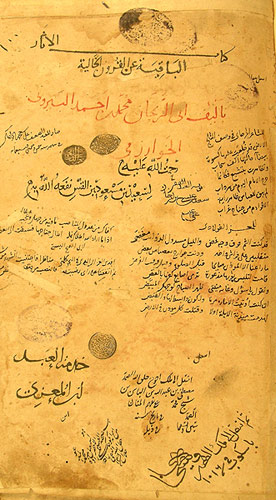
The first folio of al-Biruni’s work "The Chronology of Ancient Nations”
from the Codex Beyazit 4667, 17th c. Istanbul, Beyazit Library.

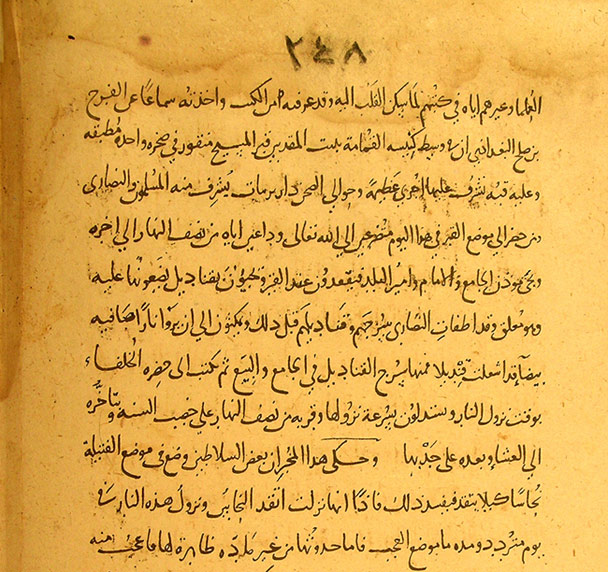
The text by al-Biruni on the rite of the Holy Fire. The narrative begins at the end of folio 347 and continues on folio 348. MS Beyazit 4667, 17th c. Istanbul, Beyazit Library.14
In his work, al-Biruni writes:
|
ويحكى لسبت القيامة حكاية يبهت لها صاحب العلم الطبيعي بل لا يوجد مقرا بها، ولولا اطباق الخصوم على الأخبار عنه ذاكرين مشاهدته وتخليد الفضلاء من العلماء وغيرهم اياه في كتبهم لما يسكن القلب إليه، وقد عرفته من الكتب وأخذته سماعا عن الفرج بن صالح البغدادي ان في وسط كنيسة القمامة ببيت المقدس قبر المسيح منقور في صخرة واحدة مطبقة وعليه قبة تشرف عليها أخرى عظيمة وحوالي الصخر دار برمات يشرف منه المسلمون والنصارى ومن حضر إلى موضع القبر في هذا اليوم متضرعين إلى الله تعالى وداعين اياه من نصف النهار إلى اخره . ويجئ مؤذن الجامع والإمام وأمير البلد فيقعدون عند القبر ويجيئون بقناديل يضعونها عليه وهو معلق، وقد أطفأت النصارى سرجهم وقناديلهم قبل ذلك ويمكثون إلى أن يروا نارا صافية بيضاء قد اشعلت قنديلا فمنها سرج القناديل في الجامع والبيع. ثم يكتب إلى حضرة الخلفاء بوقت نزول النار ويستدلون بسرعة نزولها وقربه من نصف النهار على خضب السنة وبتأخره إلى العشاء وبعده على جدبها. وحكى هذا المخبر أن بعض السلاطين وضع في موضع الفتيل نحاسا كيلا يتقد فيفسد ذلك فانها اذا نزلت اتقد النحاس. ونزول هذه النار في يوم .متردد ومدة ما .موضع .العجب
|
With regard to the Saturday of the Resurrection there is a story told that surprises the researcher of natural sciences and the cause of which is impossible to be discovered. If there was no consensus of the opponents [of the miracle] and they did not attest that they had personally seen it, and even leading teachers and other individuals had not related it in their works, one could not have any trust at all. I have learned it from books and have heard it from al-Faraj ibn Salih of Baghdad that in the middle of the Church of the Resurrection in Jerusalem there is carved in a rock the Tomb of Christ, in such a manner that it is enveloped by a dome. Overhead there is a larger dome. And around the rock there are galleries; from where the Muslims watch. The Christians, and anyone else who comes that day to the place of the Tomb, pray and call upon the Almighty God from noon until nightfall. Even the muezzin of the mosque, the head imam of the prayer and the emir of the city come, and sit next to the Tomb. With them they bring oil lamps, which they place on top, while it [the Tomb] is still sealed. The Christians in the meantime have already extinguished their lamps and torches and wait, until they see a clear white fire which lights a lamp. From this fire the lamps in the mosque and the churches are lit. Next there is a written report to the caliphs concerning the time when the flame descended. From the speed of the coming [of the fire] and if it was near noon, they concluded that the year would be productive. If the coming delayed until toward nightfall and even later, they concluded that it would not be productive. He who informed me15 relates that certain sultans put a copper wire in place of the wick so it would not light and would not take place [the miracle]. However, when the fire descended the copper ignited. The coming that day of the fire from the sky, which recurs at the specific place and time, is cause for us to be in awe.16 |
Al-Biruni had not observed the rite of the Holy Fire; however, it appears as though he trusts the Arabic sources that make reference to it. From the beginning he clarifies that he would not make mention of the story of the Saturday of the Resurrection if there was no “consensus of the opponents” (اطباق الخصوم) of the miracle who had experienced the event as eyewitnesses. The “opponents” are the deniers of the miracle who as Muslims do not accept it, even though, they describe the event in a unanimous and common way. And this appears to impress al-Biruni.
In this manner his report acquires another special significance because he essentially transfers to us, or better yet he merges, the narratives of all those Muslims who experienced the miracle, but whose works are not preserved. His information also comes from an eyewitness of the rite, al-Faraj ibn Salih from Baghdad.
Αl-Biruni, as a thorough and profound scientist, gives a complete report on his sources so there is no doubt whatsoever concerning what he is saying, on a matter of a particular religious nature that caused wonder in those of his own religion.
The information that he gives us is truly invaluable. The fact that he has read about the rite of the Holy Fire in books reveals that knowledge of the paradox of the miracle was already widespread in the Muslim world from the tenth century.
His narrative has many common points with the narrative of Ibn al-Qass that we read about in a previous section. As in Ibn al-Qass’s account, al-Biruni similarly states that while the public is waiting, suddenly, “they see a clear white fire which lights a lamp.” And he continues, “from this fire the lamps in the mosques and the churches are lit.”
The mosque he is speaking of is the Dome of the Rock. The spreading of the Holy Fire to this mosque reveals the extent of the miracle’s acceptance by the Muslims but also the prestige that surrounds the miracle.
The two leaders of the city, the imam and the emir, as well as the muezzin (he who performs the call to prayer), were present near the Sepulchre with their oil lamps.
As noted by Benjamin Z. Kedar, professor of History at the Hebrew University of Jerusalem, in the time of al-Biruni the rite was essentially shared between Christians and Muslims.17 The miracle was commonly accepted and equally celebrated by all residents of the city.
Also of special significance is the record that every year a report was sent to the caliphs, namely to the caliphs of Baghdad, in which the time of the coming of the Holy Fire was recorded. A delay in the arrival of the fire was deemed an ominous sign for the coming year, while its timely appearance at the noon hour was perceived as a sign of fertility. This means that the miracle’s fame extended much further than Jerusalem and, furthermore, that it even had an impact on agricultural predictions.
Now we shall move on to a striking detail in the narrative, something we read about in the letter of the cleric Niketas to Emperor Constantine VII Porphyrogenitus. The person who informed al-Biruni relates, as an eyewitness, that certain sultans had replaced the lamp’s wick with one of copper. When the Holy Fire descended, however, even the copper wick ignited.
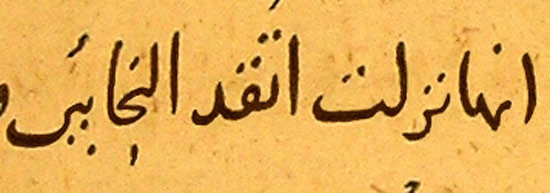
The phrase اذا نزلت اتقد النحاس, which means “however when the flame
descended the copper ignited,” from the manuscript Beyazit 4667.
It is a significant fact that this piece of information was transferred to al-Biruni from a Muslim eyewitness of the event who, since he was of another faith, had no reason at all to extol a miracle of another religion. Furthermore, this information is recorded by a learned Persian numbered among the leading scientists of all time, who notes in his final conclusion that “the coming that day of the fire from the sky” is cause for us to “be in awe” (موضع العجب = be in awe).
Even this statement alone reveals that al-Biruni had already accepted all he had been told about the miraculous event of Holy Saturday. And the reason he accepts it, as he himself explains, is because his sources are valid and there is a consensus of opinions.
As we have already underlined, the reports of al-Biruni and Ibn al-Qass make obvious the miracle’s great dissemination and acceptance among the Muslim population of Palestine. This dissemination, however, was a very unpleasant development for the leaders of the Islamic world. First, because it went against the rules of the Muslim faith, and second because it operated as a means of converting Muslims to the Christian religion.
In the year 1009, just nine years after the composition of al-Biruni’s work, the caliph of Egypt al-Hakim decided to bring an abrupt end to the annual attendance of the Holy Fire ceremony by Christians and Muslims. And in order to bring his plan to fruition he decided to set fire to and completely destroy the Church of the Resurrection, including the Holy Tomb of Christ.
Notes:
1. The number of his recorded works is 146. Included in these are 35 books on astronomy, 15 on mathematics (8 on arithmetic, 5 on geometry, 2 on trigonometry), 23 on astrology, 16 literary works, 10 on geodesy and cartography, 4 on astrolabes, 9 on geography, 2 on medicine and pharmacology, 4 historical works, 3 on religions and philosophy, 2 on mineralogy and stones, etc.
2. According to D. Tsibukidis, “Graeco-Hellenistic philosophical thought in the writings of Abu Raikhan Biruni,” Graeco-Arabica 7–8 (2000), pp. 524, 533: “In his works Biruni drew heavily upon Aristotle’s Physics, Metaphysics, De Caelo, Meteorology, Parts of Animals… He also fundamentally analysed the dialogues of Euclid, the oeuvre of Archimedes, the philosophical treatise Diacosmos of Democritus…He avidly studied the Almagest and Geographia of mathematician and astronomer Ptolemy, the treatises of the Greek physicians Hippocrates, Discorides, Galen, Oribasius, the chronicles of Eusebius… Αt a time when religious fanaticism swept medieval Europe… al-Biruni, as a forerunner of the Renaissance, was far in advance of the scientific thought then obtaining in Europe.”
3. G. Sarton, Introduction to the History of Science, vol. 1, Baltimore 1951, p. 707.
4. A.I. Sabra, “Ibn al-Haytman,” Harvard Magazine, Sept 2003.
5. F. Robertson and J. O’Connor, Al-Biruni, MacTutor History of Mathematics archive.
6. Ε.C. Sachau, The Chronology of Ancient Nations, London 1879, preface, viii. The same is supported by Μ. Canard: “L’ouvrage de Biruni à été composé en l’an 1000” (Μ. Canard, “La destruction de l’Église de la Résurrection par le calife Hakim,” Byzantion 35, 1955, p. 35).
7. MS Or 161, AD 1307, University of Edinburgh; MS Paris Arabe 1489, 17th c.; MS Beyazit 4667, 17th c.; Codex of the Asiatic Museum in St. Petersburg; MS Add. 7697, c. 1286, British Library.
8. C.E. Sachau, Chronologie orientalischer Völker von Albêrûnî, Leipzig 1878.
9. C.Η. Salemann, “Zur Handschriftenkunde, Al-Biruni’s al-Atar al-Bakiyah,” IΙAΝ (1912), pp. 861–870.
10. I.J. Krachkovsky, “ ‘Blagodatny ogon’ po rasskazy al-Biruni i drugich musul’manskich pisatelej X–XIII vekov,” Christiansky Vostok 3 (1915), pp. 235–238.
11. J. Fück, “Sechs Ergänzungen zu Sachaus Ausgabe von al-Bīrūnī’s Chronologie orientalischer Völker,”DIΙ, Berlin 1952, p. 94. For a Russian translation, see M.A. Sal’e, Abureikhan Biruni (973–1048): Izbrannye proizvedeniia, Taskent 1957, pp. 348–350.
12. Gotthard Strohmaier is Professor of Semitic and Arabic languages at the Free University of Berlin and member of the Academy of Berlin.
13. The errors identified are the following: the word الخلفا is rendered as caliph while it means caliphs. The word السلاطين is rendered as governor while it means sultans (or governors). The word الجامع is rendered as mosques while it means mosque.
14. Many times hidden behind the discovery of a manuscript fragment, such as the one under discussion, is a particularly complex and time-consuming process. Hellmut Ritter, who discovered the manuscript, recorded it with the incorrect codex number 5667, while its correct codex number is 4667. Furthermore, Johann Fück, who published the fragment on the Holy Fire, did not refer to the page numbers which contain that passage. The narrative is, in the end, to be found on pages 347 and 348, and their identification would have been impossible without the valuable assistance of Prof. Dr. Fuat Sezgin, as well as that of the Librarian of the Beyazit Library, Erdem Selcuk, both of whom I warmly thank.
15. It is not clear who he is referring to; it is possible that he means al-Faraj ibn Salih from Baghdad, who notified him verbally of the event.
16. The German translation of the original Arabic is as follows: “Vom Ostersonnabend wird etwas erzählt, das den Naturwissenschaftler in Erstaunen setxt und das er schwerlich als wahr anerkennen wird. Und wenn sich nicht die Gegner über die Nachrichten darüber einig waren und berichtet hätten, es selbst gesehen zy haben, und wenn nicht hervorragende Gelehrte und andere Leute es in ihren Büchern uberliefert hätten, konnte man sich nicht damit zufriedengeben. Ich habe es aus Büchern erfahren und auch von al-Farag ibn Salih aus Bagdad gehört, daß mitten in der Auferstehungskirche in Jerusalem das Grab Christi aus einem einzigen Felsblock ausgehöhlt ist, der es nach Art einer Grabkuppel umschließt. Darüber erhebt such eine andere große, Kuppel. Rund um den Felsen sind Emporen. Von dort schauen die Muslime zu. Die Christen, und wer sonst an diesem Tag zum ort des Grabes kommt, flehen und rufen zu Gott, dem Erhabenen, vom Mittag bis zum Abend. Es kommen auch der Muezzin der Moschee, der Vorbeter und der Emir der Stadt und setzen sich bei dem Grab nieder. Sie bringen Lampen mit, die sie daraufstellen, während es noch verschlossen ist. Die Christen haben schon zuvor ihre Lampen und Leuchter gelöscht und warten, bis daß sie ein reines weißes Feuer sehen, das eine Lampe zum Entflammen bringt. Davon werden die Lampen in der Moschee und in den Kirchen angezundet. Dann macht man an den Kalifen einem schriftlichen Bericht uber den Zeitpunkt, an dem das Feuer herabkam. Aus der Geschwindigkeit seines Herabkommens und ob es bald nach der Mittagszeit erfolgte, schießt man auf ein fruchtbares Jahr; wenn es sich aber zum Abend him verzögert oder noch später wird, auf ein unfruchtbares. Derselbe Berichterstatter teilte auch mit, ßab ein Herrscher anstelle des Dochtes einem Kupferdraht anbrachte, damit es sich nicht entzünden und das Ganze mißlingen sollte. Als aber das Feuer harabkam, brannte das kupfer. Die Herabkunft dieses Feuers an einem Tag, der nach einem bestimmten Zeitraum wiederkehrt, gibt Anlaß zur Verwunderung» (G. Strohmaier, Al-Biruni, In den Gärten der Wissenschaft, Leipzig 1988, pp. 125–126). For a French translation, see Canard, op. cit., pp. 36–37; and also I.J. Krachkovsky, “Le ‘feu beni’ d’après le récit d’al Biruni et d’autres écrivains musulmans du X au XIII siecle,” Proche-Orient Chrétien 49 (1999), pp. 261–62.
17. “Al-Biruni has Christians and Muslims praying for the fire’s coming. Thus the descent of the Holy Fire assumes the features of a ceremony shared by Christians and Muslims” (B.Z. Kedar, “Convergences of Oriental Christian, Muslim and Frankish worshippers,” in The Crusades and the Military Orders, 2001, p. 90).








